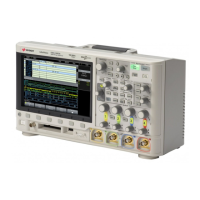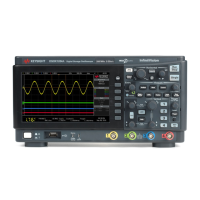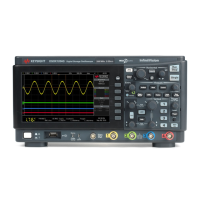94 Keysight InfiniiVision 3000T X-Series Oscilloscopes User's Guide
4 FFT Spectral Analysis
detail. Place the desired part of the waveform at the center of the screen and
decrease frequency span to increase the display resolution. As frequency span is
decreased, the number of points shown is reduced, and the display is magnified.
While the FFT spectrum is displayed, use the [Math] and [Cursors] keys to switch
between measurement functions and frequency domain controls in FFT Menu.
Decreasing the effective sampling rate by selecting a greater time/div setting will
increase the low frequency resolution of the FFT display and also increase the
chance that an alias will be displayed. The resolution of the FFT is the effective
sample rate divided by the number of points in the FFT. The actual resolution of
the display will not be this fine as the shape of the window will be the actual
limiting factor in the FFTs ability to resolve two closely space frequencies. A good
way to test the ability of the FFT to resolve two closely spaced frequencies is to
examine the sidebands of an amplitude modulated sine wave.
For the best vertical accuracy on peak measurements:
• Make sure the probe attenuation is set correctly. The probe attenuation is set
from the Channel Menu if the operand is a channel.
• Set the source sensitivity so that the input signal is near full screen, but not
clipped.
•Use the Flat Top window.
• Set the FFT sensitivity to a sensitive range, such as 2 dB/division.
For best frequency accuracy on peaks:
• Use the Hanning window.
• Use Cursors to place an X cursor on the frequency of interest.
• Adjust frequency span for better cursor placement.
• Return to the Cursors Menu to fine tune the X cursor.
FFT Resolution
The FFT resolution is the quotient of the sampling rate and the number of FFT points (f
S
/N).
With a fixed number of FFT points (up to 65,536), the lower the sampling rate, the better the
resolution.
